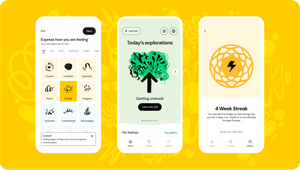
How Businesses Can Get Unstuck in 2024 with Matthieu Mingasson

AI’s Purpose is Different Than You Think it Is
In 2024, business leaders will have to come to the realisation that AI is mostly about humans, not about AI. What do I mean by that? Conversations on AI today are strictly technologically focused. With AI, we act like kids who got their new toy at Christmas. We are all amazed by every new update in Generative AI tools. How large language models (LLMs) can be incredibly trained. How fast they can respond. How data can be sanitised and how we can contextualise LLMs with vector databases. That’s all fine, but what will be critically missing soon in those conversations is the focus on humanity — meaning not just people (users, customers, patients, employees), but everything that comes with it: culture, values, biases, and most importantly, emotional intelligence.
We have the responsibility to focus on humanity when we design with AI. We have to take into account how human beings function so what we create with AI is beneficial, not harmful, to our collective intelligence, or we will end up creating the future depicted in our most terrifying science fiction movies.
As a technology-first creative agency, Code and Theory infuses the human dimension into everything we create. We empathise with the needs of business leaders, who are approaching us about everything from the AI tech stack, to process and governance to data migration and more. We’re positioning the future around a holistic AI strategy that is organised by four key principles:
1. Understand human behaviours and biases.
2. Align your organisation with a benevolent vision.
3. Put creativity at the core of everything you do.
4. Create a culture of empathy.
When Process and Prioritisation Becomes a Pitfall
Too often I see leaders across the business spectrum who think integrating a new process and levels of prioritisation is a one-size-fits-all solution. But no process or prioritisation can make up for a lack of vision and alignment, or a missing differentiated brand story.
The culture of business in our modern society is very left-brained. It loves order, even numbers, processes, charts, repetition, automation and predictability. In fact, it loves the left brain so much that anything coming more obviously from the right brain, such as creativity and intuition, is not expected nor even welcomed in some business situations. So we analyse data, we build processes, we put numbers in columns, we put capabilities in silos and we prioritise initiatives by level of effort. We expect this approach to solve our organisational problems while we obviously can witness the lack of true efficacy in this approach. Like everything related to cognition, education and training play huge roles in the development of creative capabilities. Education institutions encourage mixing analytical activities with highly creative ones, as it is proven that a balanced combination of left and right brain activities makes people more effective.
This all comes back to the rallying cry of every company: its brand story. This is not a fantasy of the right brain — it’s a reason to believe. The brand story is as much for the folks on your team as your customers. Powerful stories are usually what’s missing in most companies’ strategies. Without a good story that embodies a vision, nothing is actually solid. Opinions can change, priorities can shift and things are unstable and uncertain. So ironically, by ignoring creativity and inspiration (right brain) in the search for rationality (left brain), we generate a very unstable ground for transformation.
Why Companies Need Design Transformation
Design transformation is the practice of helping organisations get unstuck. It’s the practice of generating future value for customers and businesses by increasing organisations’ ability to identify problems, experiment with solutions and operate change.
I can’t emphasise enough how most transformation efforts are missing the point. Did you know that two-thirds of digital transformation initiatives fail? Why is that? And why do companies keep hiring very expensive, old-school management consultants for digital transformation when this approach has repeatedly proven itself largely unsuccessful?
Any transformational initiative is a human-to-human situation, and this requires examining how people behave, how they work and how they interact with each other. That’s much different — and harder — than looking at systems and how many tasks are involved in a process. To quote Ray Dalio, founder of Bridgewater Associates, “The biggest problem that humanity faces is an ego sensitivity to finding out whether one is right or wrong and identifying what one’s strengths and weaknesses are.”
Code and Theory has a long history of putting creativity and design at the centre of everything we do, not because it’s fancy and different, but because it truly works. Design is a much better approach to digital transformation than any other traditional methodologies coming from management consulting firms because it allows human interactions and collaboration to be discussed and improved. When teams work better together, they ultimately create better customer experiences.
Time for Leaders to Become Entrepreneurs Within Their Own Firms
Look across, not down or up. Do not look at your department for innovation; look at what other departments are doing. Do not look at your own team and tell them what to do; instead, look at what other disciplines are creating. Do not look at your boss for guidance when you’re stuck; learn from experts from a completely different field. And most importantly, do not create initiatives that overlap your department; create projects that combine a wide diversity of disciplines and practices. Be an entrepreneur within your own firm. Don’t think linearly if you want to transform things. Think organically.
For more, sign up for: “Remove roadblocks, map a way forward: A Workshop to Drive Transformation.”















